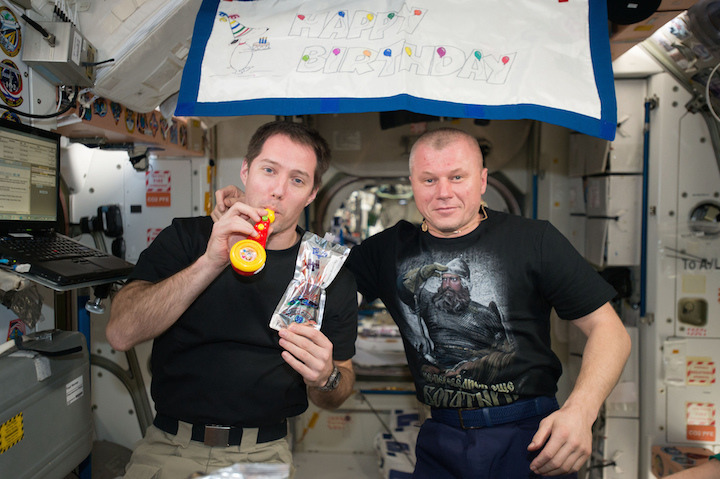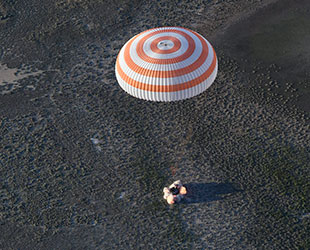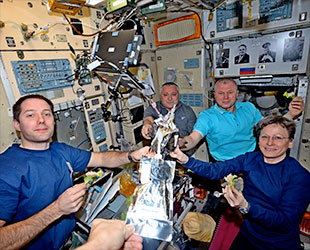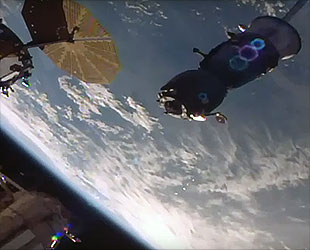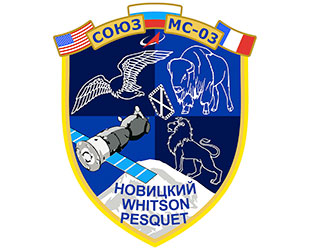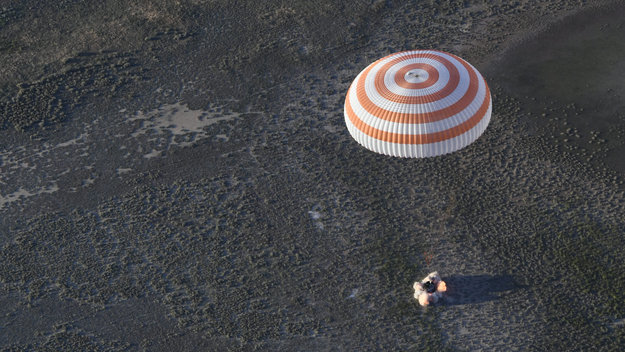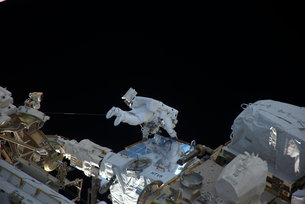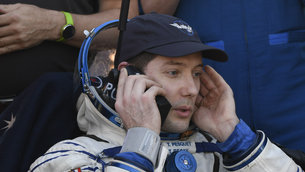Leaving crewmate Peggy Whitson behind in orbit for an extended mission, a Russian cosmonaut and his French co-pilot undocked from the International Space Station early Friday, setting the stage for a fiery plunge to Earth and a landing on the steppe of Kazakhstan to close out a 196-day mission.
Soyuz MS-03 commander Oleg Novitskiy and European Space Agency astronaut Thomas Pesquet shared a final round of hugs and handshakes with Whitson, Expedition 52 commander Fyodor Yurchikhin and astronaut Jack Fischer, boarded their ferry ship and closed the hatch at 3:35 a.m. EDT (GMT-4).
"You guys take care," Fischer called out a few moments earlier.
Two hours later, at 6:47 a.m., powerful springs gently pushed the Soyuz away from the station's Earth-facing Rassvet module.
After moving a safe distance away, Novitskiy planned to oversee an automated four-minute 36-second de-orbit rocket firing starting at 9:17 a.m. to slow the spacecraft by about 286 mph, just enough to drop the far side of the orbit into the atmosphere.
If all goes well, the Soyuz MS-03 crew compartment will drop to a parachute-and-rocket-assisted touchdown 89 miles southeast of Dzhezkazgan, Kazakhstan, at 10:10 a.m. (8:10 p.m. local time), the first landing by a two-person Soyuz crew since March 18, 2010, when astronaut Jeff Williams and cosmonaut Maxim Suraev came home.
As usual, Russian and European Space Agency recovery crews and flight surgeons were standing by to assist the returning station fliers as they begin re-adjusting to gravity. Novitskiy's total time in space over two missions will stand at 340 days while Pesquet will have logged 196 days aloft on his first flight.
During their six-and-a-half months in space, the Soyuz MS-03 crew completed 3,136 orbits covering 82.9 million miles. They helped welcome five visiting vehicles -- four cargo ships and a crew ferry flight -- and Pesquet participated in two spacewalks totaling 12 hours and 32 minutes.
"We are, of course, going to miss Oleg and Thomas," Whitson said Thursday, choking back tears. "They are exceptional astronauts in every sense of the word. But mostly, we're going to miss their sense of humor and camaraderie."

Space station commander Fyodor Yurchikhin, left, makes final preparations for undocking while Soyuz MS-03 commander Oleg Novitskiy and Thomas Pesquet look on from inside the hatch of their ferry craft.
Said Pesquet: "It was a great adventure. Just want to say for me and Oleg, we were really proud to be part of such a team and fly with Peggy. Peggy's a legend, but she's also absolutely unbelievable to work with or just hang around with, live with in space."
Whitson flew into space with Novitskiy and Pesquet last Nov. 17. She originally expected to come home with them, but in April, her mission was extended to Sept. 3.
"We're a little bit sad to leave her behind, but we're not staying!" Pesquet laughed during a change-of-command ceremony Thursday. "We know she's in good hands. ... Now is the time for us to go back home to our friends and family, and we're happy. But it's also a bittersweet feeling because we know this is such a unique place that you sometimes get to experience only once. It was fantastic, thanks to everybody."
After initial medical checks and satellite phone calls to family and friends, Novitskiy and Pesquet will be flown by helicopter to the town of Karaganda for an official Kazakh welcome ceremony. Novitskiy then will board a Russian jet for the flight back to Star City near Moscow while Pesquet boards and ESA aircraft and returns to Cologne, Germany, for debriefing.
On Thursday, Whitson turned over command of the station to Yurchikhin.
"Today, I hand over (command) to Fyodor Yurchikhin, the only guy I've flown three times with," she said. "So welcome to your command."
"It's an honor for me working with you, Peggy," said Yurchikhin, speaking in English. "We use your experience in space, your soul, your smarts. The greatest person, an amazing person. Sometimes, everybody says Peggy is 'iron woman,' 'steel woman.' She's amazing woman, an amazing person in space. Thank you very much. So welcome on board to Expedition 52."
Yurchikhin and Fischer took off aboard the Soyuz MS-04 spacecraft on April 20. In a move to save money in the near term, the Russian federal space agency opted not to include a third crew member. After negotiations with Russian space managers, NASA decided to extend Whitson's mission to Sept. 3 when she will take the available seat on the MS-04 spacecraft and return to Earth with Yurchikhin and Fischer.
Keeping Whitson in space will enable additional research between the departure of Novitskiy and Pesquet and the arrival of Soyuz MS-05 commander Sergey Ryazanskiy, Randy Bresnik and ESA astronaut Paolo Nespoli on July 28. It also preserves the option for a two-person NASA spacewalk in an emergency.
Whitson is America's most experienced astronaut with 573 days in space over three missions as of Friday. When she returns to Earth Sept. 3, her cumulative time in space will stand at 666 days, moving her up to eighth in the world. Whitson is also No. 3 in the world in total spacewalk time with more than 60 hours of EVA time over 10 excursions.
Quelle: CBS
+++
THOMAS PESQUET RETURNS TO EARTH
ESA astronaut Thomas Pesquet landed on the steppe of Kazakhstan today with Russian commander Oleg Novitsky in their Soyuz MS-03 spacecraft after six months in space. Touchdown was at 14:10 GMT after a four-hour flight from the International Space Station.
The return was routine – or as routine as you can get for a ride that requires braking from 28 800 km/h to zero. The heatshield copes with the 1600°C as the spacecraft enters the atmosphere, parachutes and retrorockets provide the final braking, and moulded seats cushion the impact – but it is still a wild ride.
The next voyage will be more sedate as Thomas flies directly to ESA’s astronaut centre in Cologne, Germany, for debriefing and tests. Researchers are eager to investigate how his body has adapted to living in weightlessness for six months.
Proxima
Thomas took part in more than 60 experiments during his Proxima mission and set a new record for the number of hours spent on science in a week as part of an Expedition crew.
His experiments are helping to understand the human brain, ocean currents and radiation in space, how atoms behave and tested new spacecraft materials. Other highlights included his two spacewalks to improve and maintain the Space Station.
“Glad to see Thomas and Oleg back on Earth after another astounding mission,” comments David Parker, ESA’s Director of Human Spaceflight and Robotic Exploration. “The Space Station’s allure for researchers and space agencies is its continuous operation and ground teams around the world keep it running 24/7.
“The next ESA astronaut to be launched will be Paolo Nespoli next month, ensuring science and technology demonstrations in space continue for the benefit of humankind.”
With Thomas and Oleg back on Earth, three astronauts remain on the orbiting outpost: NASA astronauts Peggy Whitson and Jack Fischer, and Roscosmos cosmonaut Fyodor Yurchikhin. Peggy was launched with Thomas and Oleg on 16 November 2016 but will return at a later date.
Quelle: ESA

